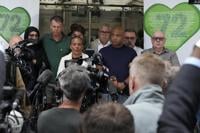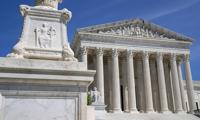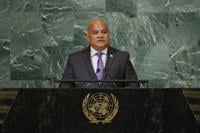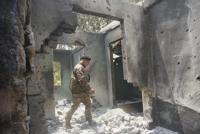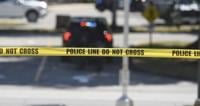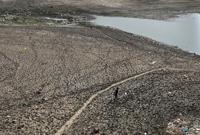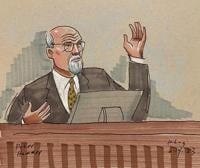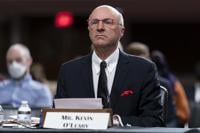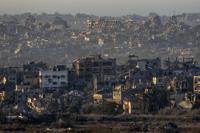LONDON (AP) — Britain’s worst residential fire since World War II led to deaths of 72 people in a high-rise apartment building in west London more than seven years ago.
An inquiry, whose final report is being released Wednesday, began soon after the fire at Grenfell Tower, which broke out in the early morning hours of June 14, 2017, and quickly engulfed the 25-story public housing building.
Here is a summary of how the disaster evolved and what happened after the flames were extinguished:
June 14, 2017
At 12:54 a.m., a call is made to the London Fire Brigade reporting that a fire has broken out in a fourth-floor apartment at Grenfell Tower. Barely half an hour later, flames have swirled to the roof of the building.
The fire’s rapid spread is quickly blamed on flammable cladding made of aluminum composite material (ACM), which had recently been installed as part of a building refurbishment. Survivors also question why people were told to remain in their apartments as fire engulfed the building.
June 15, 2017
Prime Minister Theresa May announces a public inquiry into the fire. Martin Moore-Bick, a retired court of appeal judge, is appointed to lead the inquiry two weeks later.
July 28, 2017
Judith Hackitt, a chemical engineer and former chair of Britain’s national workplace safety regulatory, is appointed to conduct review of building regulations.
Sept. 19, 2017
London’s Metropolitan Police widens its criminal investigation into the fire, with detectives considering individual as well as corporate manslaughter charges.
Nov. 30, 2017
A petition, backed by singer Adele, urges then-Prime Minister May to expand the Grenfell inquiry panel because of concerns that Moore-Bick lacked first-hand experience of life as a social tenant in a multicultural neighborhood.
Jan. 29, 2018
Maria del Pilar Burton, a 74-year-old survivor, dies in palliative care. She is considered the 72nd victim of the fire.
May 17, 2018
Hackitt recommends “fundamental reform” of fire safety rules in a report that describes a “race to the bottom” on building safety as building owners put the drive to save money ahead of safety.
May 21, 2018
The inquiry begins with seven days of hearings commemorating the dead, starting with a tribute to the fire’s youngest victim, stillborn Logan Gomes.
June 14, 2018
A year after the fire, survivors and bereaved relatives gather to lay white roses at the foot of Grenfell Tower. They are joined by rapper Stormzy, a London native who supported the residents’ drive for better representation at the inquiry. Across the country, people observe 72 seconds of silence in memory of the victims.
June 21, 2018
Firefighters begin giving evidence to the inquiry. London Fire Brigade Commissioner Dany Cotton tells the inquiry she would change nothing about her team’s response on the night of the fire. Survivors react with anger.
Sept. 30, 2018
The British government bans combustible cladding on all residential buildings above 18 meters (59 feet), as well as schools, care homes, student accommodation and hospitals.
June 18, 2019
Survivors and bereaved families project a message on to the Houses of Parliament reading: “Two years after Grenfell, this building still hasn’t kept its promises #DemandChange.”
Oct. 30, 2019
The inquiry releases its report on the first phase of its investigatiion. It attributes the rapid spread of flames to ACM panels with polyethylene cores, “which acted as a source of fuel.”
It also criticized the London Fire Brigade for allowing a “stay in place” order to remain in effect even after it became clear safety systems were failing, leading to an increased loss of life.
The report’s recommendations include calls for legislation to require evacuation plans for all high-rise residential buildings, more frequent inspections of elevators and fire doors, better training for firefighters and improved communication among emergency responders.
Nov. 6, 2019
Jacob Rees-Mogg, then the leader of the House of Commons, apologizes for suggesting Grenfell victims should have used “common sense” and ignored fire service guidance not to leave their apartments.
Feb. 24, 2020
Campaigners urge the government to create a multibillion-pound fund to replace dangerous cladding after research suggests that more than half a million people could be living in unsafe homes. The Association of Residential Managing Agents said that while Grenfell highlighted the dangers of ACM cladding, it also revealed a much wider building safety crisis.
March 11, 2020
Rishi Sunak, then Britain’s Treasury chief, creates a 1 billion pound fund to remove unsafe cladding from high-rise residential buildings.
Jan. 19, 2021
The government promises to create a new regulator to improve the safety of building materials after the Grenfell inquiry had “shone a light’’ on dishonest practices by some manufacturers, including “deliberate attempts to game the system and rig the results of safety tests.’’
Feb. 10, 2021
Robert Jenrick, then housing secretary, announces a new 3.5 billion pound package to pay for the removal of unsafe cladding from medium- and high-rise buildings. Critics say the program doesn’t do enough to address the problems of people who bought apartments in unsafe buildings and are now unable to sell because of delays in addressing fire safety issues.
June 14, 2022
Prince William and British politicians join in memorial services to mark five years since the fire. Some say Grenfell families feel “abandoned” after half a decade of “betrayal” by the housing department and slow progress on safety improvements.
May 2024
London’s Metropolitan Police Service confirms that bereaved families and survivors may have to wait until the end of 2026 for a decision on potential criminal charges. The Met says police won’t complete their investigation until the end of 2025, and prosecutors are likely to need another year to determine whether any charges will be brought.
July 2024
Government figures show the slow pace of removing dangerous cladding from buildings in England. While authorities have identified 4,630 residential buildings of 11 meters (36 feet) or more that have unsafe cladding, only around half (2,299) have either started or completed remediation works. Less than a third (1,350) have completed the work.
Aug. 26, 2024
A huge fire at an apartment building in east London reminds people of the dangers of combustible cladding. While no one died in the fire, more than 80 residents were evacuated from the six-story building where contractors were removing “non-compliant” cladding.
Sept. 4, 2024
Final report of the Grenfell Inquiry is published.


